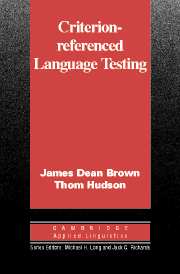Book contents
- Frontmatter
- Contents
- Series editors' preface
- Acknowledgements
- Preface
- 1 Alternate paradigms
- 2 Curriculum-related testing
- 3 Criterion-referenced test items
- 4 Basic descriptive and item statistics for criterion-referenced tests
- 5 Reliability, dependability, and unidimensionality
- 6 Validity of criterion-referenced tests
- 7 Administering, giving feedback, and reporting on criterion-referenced tests
- References
- Index
7 - Administering, giving feedback, and reporting on criterion-referenced tests
Published online by Cambridge University Press: 05 October 2012
- Frontmatter
- Contents
- Series editors' preface
- Acknowledgements
- Preface
- 1 Alternate paradigms
- 2 Curriculum-related testing
- 3 Criterion-referenced test items
- 4 Basic descriptive and item statistics for criterion-referenced tests
- 5 Reliability, dependability, and unidimensionality
- 6 Validity of criterion-referenced tests
- 7 Administering, giving feedback, and reporting on criterion-referenced tests
- References
- Index
Summary
Introduction
In this chapter, we would like to wrap up a number of loose ends that have not been covered in previous chapters and, at the same time, review some of the key concepts involved in criterion-referenced testing. To those ends, we will provide practical suggestions based on our experiences with real criterion-referenced testing projects in three major areas: developing criterion-referenced tests, giving criterion-referenced feedback, and reporting criterion-referenced results. In addition, we will also provide access to a sample report of a CRT project along with commentary with some suggestions on writing such reports.
Developing criterion-referenced tests
Most language teaching professionals have some experience developing and administering tests on their own for their own classes. In many cases, a number of teachers will be assigned different sections of the same course; at the end of the courses, the teachers develop separate tests for each of their classes. Especially if the course has common objectives across all of the sections, such test development practices seem to us to be duplicative, redundant, and inefficient. We will focus in this section on two sets of strategies that can be used to get teachers to work together on CRT projects. These strategies will be discussed in two main sections – one on fostering teacher cooperation and the other on marshaling adequate resources. We will also discuss the issues involved in developing multiple forms of a CRT so they can be administered in a counterbalanced manner.
- Type
- Chapter
- Information
- Criterion-Referenced Language Testing , pp. 269 - 291Publisher: Cambridge University PressPrint publication year: 2002

